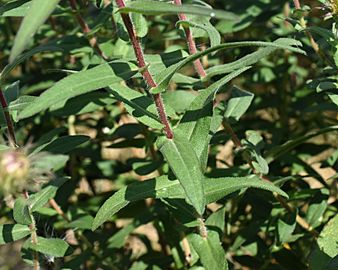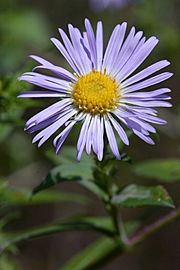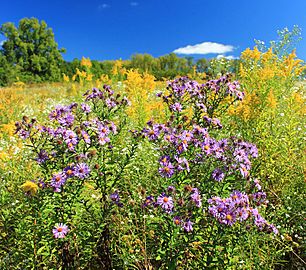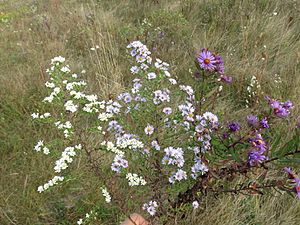Symphyotrichum novae-angliae facts for kids
Quick facts for kids New England aster |
|
|---|---|
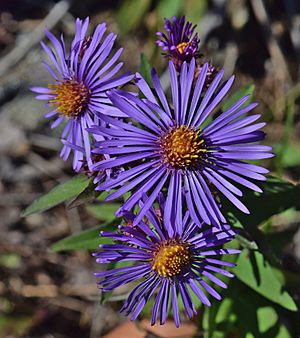 |
|
| New England aster blooming in Addington Highlands (Ontario, Canada). | |
| Conservation status | |
| Scientific classification | |
| Genus: |
Symphyotrichum
|
| Species: |
novae-angliae
|
| Synonyms | |
|
List
Aster altissimus Moench
Aster concinnus Colla Aster novae-angliae L. Aster novae-angliae f. geneseensis House Aster novae-angliae var. monocephalus Farw. Aster novae-angliae f. rosarius House Aster novae-angliae f. roseus (Desf.) Britton Aster novae-angliae f. spurius (Willd.) Voss Aster roseus Desf. Aster spurius Willd. Lasallea novae-angliae (L.) Semple & Brouillet Virgulus novae-angliae (L.) Reveal & Keener |
|
The New England aster (scientific name: Symphyotrichum novae-angliae) is a beautiful flowering plant. It belongs to the daisy family called Asteraceae. This plant is a perennial herb, which means it lives for more than two years. It grows naturally in eastern North America. People have also brought it to Europe.
This plant blooms in the fall. Its seeds and nectar are very important food sources. Many different animals rely on them. The New England aster is also a popular garden plant. People especially love to grow it in Europe. Many different types, called cultivars, have been created.
Contents
What Does the New England Aster Look Like?
The New England aster is a perennial plant. It grows from about 30 to 120 centimeters (about 1 to 4 feet) tall. Several strong, hairy stems grow straight up from one spot. These stems usually do not have many branches.
The leaves are long and narrow, shaped like a spear. They do not have teeth along their edges. The leaves also wrap around the stem. When the plant flowers, the lower leaves often dry up.
-
Flowering with goldenrod (Solidago)
The plant has many showy flower heads. They bloom from August to November. The center of each flower head has yellow disc florets. The outer petals, called ray florets, can be deep purple, rose pink, or sometimes white. Many different types of New England asters have been grown. They might look a bit different from these general descriptions.
How Scientists Name This Plant
The New England aster used to be part of a large group of plants called Aster. Its old name was Aster novae-angliae. But scientists found that the Aster group was too broad. Now, most North American asters, including this one, are in a different group called Symphyotrichum.
Sometimes, the New England aster mixes with another plant called Symphyotrichum ericoides. This happens where both plants grow. When they mix, they create a new plant called Symphyotrichum × amethystinum. This new plant looks like a mix of both parent plants.
The common name "Michaelmas-daisy" comes from the fact that many asters, including this one, often bloom around September 29. This date is known as the feast of St. Michael.
Where the New England Aster Grows
The New England aster is native to a large part of central and northeastern United States. It also grows naturally in southeastern Canada. You can find it from Manitoba in the north down to Louisiana in the south. It also grows east to Maine. It does not grow in the very far southeastern United States. It is also not found in the cold boreal areas of Canada.
Sometimes, you can find small groups of these plants further west. For example, they grow in New Mexico and the Black Hills of South Dakota.
Because people plant them so much, you can now find New England asters in other places. These include Nova Scotia, Montana, Oregon, Utah, Washington, and Wyoming. They also grow widely in most of Europe and parts of Central Asia. You can even find them growing wild in New Zealand.
Where It Likes to Live
This plant likes to grow in many different open places. These places are usually moist. You can find it in meadows, prairies, marshes, and fens. It also grows at the edges of forests. You might see it in places changed by people, like roadsides or old farm fields. The soil where it grows often has a lot of calcium.
New England Aster and Its Animal Friends
The New England aster can make new plants in two ways. It can spread using short underground stems called rhizomes. It also makes seeds that the wind carries away. This plant cannot usually pollinate itself. It needs cross-pollination from other plants to make seeds. Its seeds are an important food for many songbirds.
Many different insects visit the New England aster for its nectar. These include butterflies, moths, ants, flies, and bees. Long-tongued bumblebees, like Bombus fervidus and Bombus vagans, visit it a lot. Shorter-tongued bees visit less often. Some bees, like Megachile latimanus and Melissodes druriella, also collect pollen.
A small insect called a gall midge (Rhopalomyia astericaulis) can make a gall on the stem. This gall is about 2 centimeters (0.8 inches) long. Other insects, called leaf-mining insects, live inside the leaves. These include certain beetles and flies.
Some butterfly caterpillars also eat the New England aster. These include the Gorgone checkerspot (Chlosyne gorgone) and the pearl crescent (Phyciodes tharos). A beetle called Exema canadensis also lays its eggs on this plant.
How People Use the New England Aster
Growing in Gardens
More than 70 different types of New England aster have been created for gardens. About 50 of these are still sold today. These garden types usually grow between 90 and 180 centimeters (about 3 to 6 feet) tall. One type, 'Purple Dome', is much shorter, growing under 60 centimeters (2 feet).
The New England aster became popular in Europe in 1710. It has only recently become a common garden plant in North America.
Some types of New England aster have won awards. The Royal Horticultural Society has given its Award of Garden Merit to these:
- 'Brunswick' (which has bright pink flowers)
- 'Helen Picton' (which has purple flowers)
- 'James Ritchie' (which has deep pink flowers)
Traditional Medicine Uses
Native American people in North America have used the New England aster for medicine for a long time. Here are some ways they used it:
- The Cherokee people used a paste from the roots for pain. They also made a drink from the roots for diarrhea. They sniffed the liquid from the roots to help with stuffy noses. A drink from the whole plant was used for fevers.
- The Chippewa people smoked the roots in pipes. They believed this would help them attract game animals.
- The Iroquois people made a strong tea from the plant for weak skin. They also made a tea from the roots and leaves for fevers. A tea from the whole plant and rhizomes of another plant was used to help mothers with fevers after childbirth.
- The Meskwaki people used the plant for smudging. They would burn it and use the smoke to help people who had fainted.
- The Potawatomi people also used it to help revive unconscious people with smoke.



